Crane for urinal - types of designs and recommendations for
Urinals have become a familiar element in the bathrooms of public premises and offices, but recently this type of construction has become increasingly common in apartments and private homes. Their presence significantly increases the comfort of living, especially in multi-storey buildings and two-level apartments, because there can be one toilet bowl and urinals on each floor. The urinal flush valve is an obligatory attribute of the structure, which largely determines the hygiene of the system, so it is worthwhile to dwell on this node in more detail.
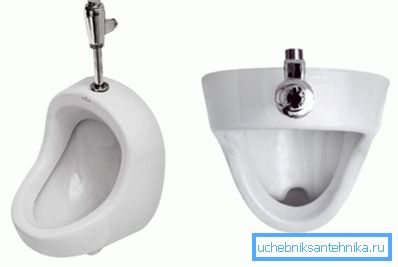
How to choose a quality product
Regardless of which modification you choose, it is important that it meets the following criteria:
| Quality | Best of all, if the crane meets the requirements of GOST 19681-94 and GOST 25809-96, this ensures that the assembly is manufactured in accordance with the standards and has all the necessary characteristics. Of course, foreign analogues are manufactured in accordance with other standards, but if such products have a certificate of conformity, then they are suitable for our operating conditions. |
| Compliance design | The faucet must comply with the design of the urinal, the bowls can be of the most varied forms, and not all the variants of valves and fittings are suitable for them. It is best to purchase a crane complete with the main product or in the same store, this ensures that all elements fit together. |
| Aesthetics | Covering the product should be attractive, without any defects and stains. This is due to the fact that the appearance of high-quality cranes is much better, moreover, any flaws in high humidity conditions are potential foci of corrosion. |
| Efficiency | This concept means not so much a low price as an economical consumption of water. Even a small difference in this indicator over the years of operation is formed in cubic meters of water and thousands of rubles saved. |
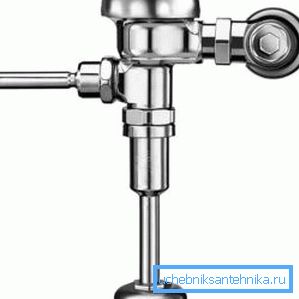
Types of drainage systems
All products of this group can be divided into three main groups. They have their differences, so we consider each of them in more detail and in detail.
Continuous drain
This option is practically not used in ours because of the huge waste of water, because it is served continuously.
The main features of such communications are the following factors:
- The crane in the system is constantly open, most often it is one for several, or even dozens of urinals, and water is supplied simultaneously to all the structures.
- In addition to the high flow of water, this variant has noise and high humidity in the room., which is completely undesirable, because it negatively affects the furniture and decoration materials.
- Another major drawback is that, due to the constant flow of water, a lime scale and rust stains quickly form on the surface of urinals., therefore, you need to wash the sink every day, especially if the water quality is not very good.

Manual version
This type is different from the above, and has a number of features, which we will discuss below:
- Each bowl is equipped with a separate valve., button or lever when you want to run flush. This saves water, because it does not flow continuously.
- This option is used most often in apartments and houses.. It is also used in public places, but there are many questions about the hygiene of this decision. After all, the button touches many people, and there is no way to guarantee the cleanliness of the surface. That is why this flush is very often not used.
- The faucet is most often located above the urinal or directly on it. One part of it is connected to water supply communications, and the second goes directly to the urinal.
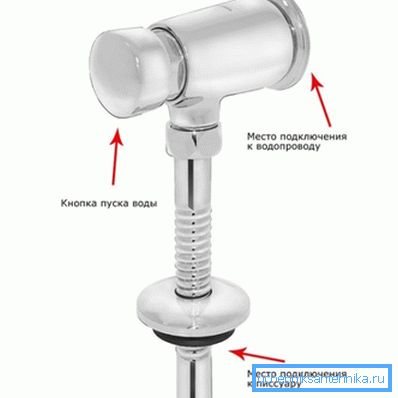
Tip! Particular attention should be paid to the attachment of the crane to the urinal, there must necessarily be a rubber gasket, it must be flexible and fit snugly to the surface, otherwise leakage during operation cannot be avoided.
- The advantages of the system include the following factors: democratic cost, simplicity of design (for example, the popular KRS 20-05 flush valve is notable for its simplest device) and simple installation instructions - it’s quite realistic to do all the work yourself without the involvement of qualified specialists.
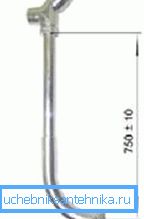
It should also be noted that the most important requirement for the nodes of this group is reliability and durability, a urinal crane according to GOST can be manufactured even without an outer covering, but for the house one should still choose more attractive options.
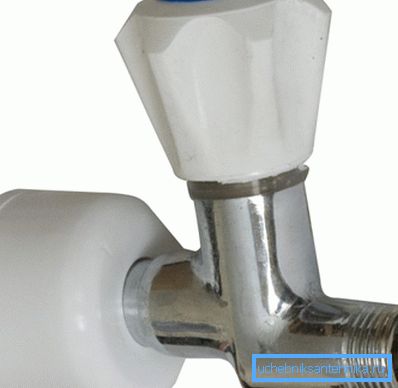
Automatic systems
This is the most modern version, which appeared relatively recently, but has already gained immense popularity due to a number of advantages:
- A crane for a urinal in such a system is opened by means of a system of sensors that react to a fluid or to a person approaching it. This allows you to use flush only when necessary, and saves water.
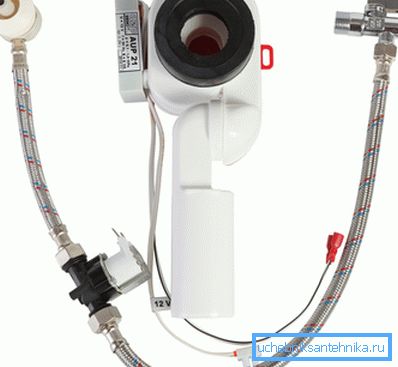
- This option is highly hygienic, because you don’t need to touch any elements at all, everything happens automatically.
- In most of these systems there is a built-in protection against leakage, this allows you to stop the water supply in case of problems in the device.
- Outside there are no nodes and systems, which significantly improves the appearance of the structure and makes the bathroom much neater. (See also the article Toilet bowl: features.)
Remember! The factor that all elements are hidden and located inside the case prevents their damage and significantly prolongs the system resource. As a rule, the service life of communications is quite large, which is also an important advantage.

Conclusion
Choosing a crane for a urinal is much more important than it seems at first glance, because it affects the performance of the system and its proper and economical operation, as a rule, the pressure valve for a urinal is used most often, because its cost is low. The video in this article will tell some important factors about the valves in this group.